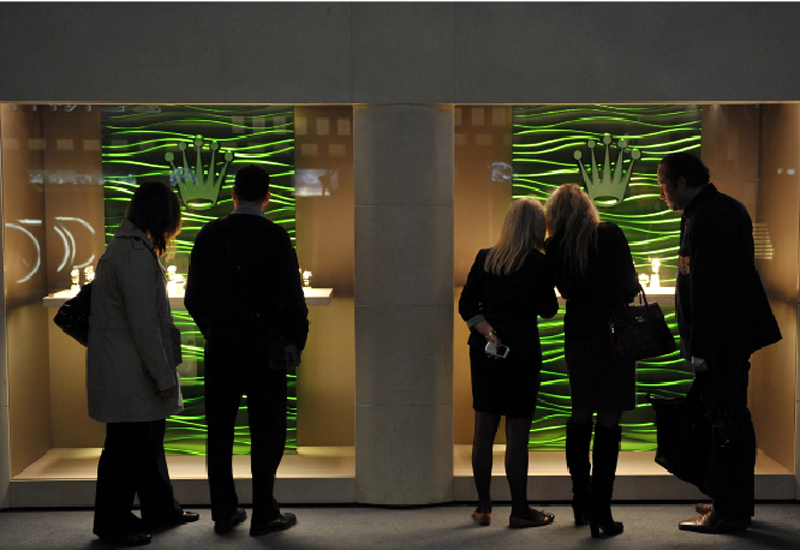The middle market of the UK watch industry could be set for a difficult year, according to data from analyst GfK, as watches in the over €5,000 and under €500 brackets show the most growth potential for the months ahead.
At a presentation given in BaselWorld by GfK global product manager of watches Jonathan Hedges these upper and lower segments were described as holding the most potential for watch retailers. Hedges added that he expected watch brands with products in the €501 to €4,999 bracket to struggle to win sales as the watch market becomes increasingly polarised.
In 2011 sales of watches priced at more than €5,000 in the UK showed a growth of 23.3%, the greatest growth of all the price sectors tracked by GfK. In second to fourth place were sectors under €500, with watches less than €100 registering 20.2% growth, watches priced at €100 to €200 showing growth of 13.4% and the €200 to €500 sector registering growth of 12.5%. All other sectors that sit between €500 and €5,000 registered single-digit growth, and this is a sales trend that Hedges expects to continue to play out in 2012.
This forecast is one that David Coleridge, managing director at DM London, which controls The Watch Hut and The Watch Gallery as well as the Rolex boutique at One Hyde Park and the watch offer at Asos and John Lewis, said is playing out at his retail outlets.
“Our sales at present might suggest this; the top and the bottom are outperforming the middle,” he said. “But the most obvious factor is that the strong brands are doing very well and with large groups and massive resources behind them are dominating the industry.”
Patek Philippe UK managing director Mark Hearn has noted the weakening of the middle market, but rather than this being restricted to watches he believes it to be a retail-wide symptom of the recession. Watches at the brand start at about £10,000 – well into the over €5,000 category – and Hearn said that its shoppers are seeking out luxury classics. “In the current climate, customers do not want to be too ostentatious and therefore their choices reflect authentic and traditional values,” he said.
At the other end of the scale, Coleridge describes watches under £500 as performing fantastically well for DM London. “Watches which retail from £50 to £500 had a fantastic Christmas and are continuing strongly this year,” he said.
Independent jeweller Steffans has felt the weakening of the middle market hit its sales in Northampton and director Wes Suter attributes it to the decline of what he calls the “BMW man”. “It is the guy that was able to get the credit cards and so get the BMW 3 Series,” he explains. “All the money he had was on the tick, but now, what with the banks the way they are, these guys can no longer buy the products. He was spending a couple of grand, [but now that he’s not] that £2,000 sweet spot sale is no longer there anymore. It’s being polarised.”
Suter said that the polarisation has encouraged Steffans to take on brands it has not dealt with in the past that sit under the £500 threshold such as Tissot, which he said is performing well for the store. After taking on lower-priced brands and seeing returns in terms of the volume of sales, Suter says that it is hard to put faith in stocking middle-market brands after discovering there is more revenue to be made from selling a higher volume of lower-priced watches.
Seiko UK has also noted this polarisation and marketing manager Kirsten Crisford said its a trend that she expects to continues this year. She added that for the under €500 bracket average purchase prices have been rising, while the group is pinpointing the over €5,000 market as a potential area for growth that it intends to push into with its premium Grand Seiko line.
While Seiko is chasing price points of up to £20,000 with Grand Seiko, Andrew Manders of Mallorys in Bath believes that the sudden growth of the over €5,000 bracket as described by GfK is less to do with an increase in sales of very highly priced watches and more to do with those on the cusp. In particular he believes the rise in this sector has been led by a shift in the average price of Rolex watches, following a price hike last year that has taken that price just over the €5,000 line.
“It’s no coincidence that one brand has moved across the price point,” said Manders. “Shoppers are following the brands, not the price point.”
While the middle market might be showing less growth potential there are always exceptions to the rule. Alexander Kustow, distributor of Nomos Glashütte and Meistersinger, said the brands enjoyed their best BaselWorld in March, while Frederique Constant distributor Argento Fine Products said its brand, which has an average price point of £1,200, has experienced “tremendous” growth in the UK.
This article was taken from the April 2012 issue of WatchPro magazine. To read a digital version of this issue online click here.

